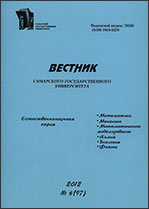|
This article is cited in 1 scientific paper (total in 1 paper)
Mathematical Methods in Natural Sciences
Model of self-oscillations without harmonicas of the base frequency
V. V. Zaytceva, E. Yu. Fedyuninb
a Department of Radiophysics, Semiconductor Micro- and Nanoelectronics,
Samara National Research University, 34, Moskovskoye shosse, Samara, 443086, Russian Federation
b Joint-Stock Company Progress Rocket Space Centre, 18, Zemetsa
Street, Samara, 443009, Russian Federation
(published under the terms of the Creative Commons Attribution 4.0 International License)
Abstract:
The nonlinearity of self-oscillatory system limiting amplitude of the generated signal is a source of the higher harmonicas of the base frequency. Harmonicas distort a form of self-oscillations and lower stability of their frequency. In the work the mathematical model of generation of self-oscillations, free from the highest harmonicas — strictly monochromatic self-oscillations is offered. The model is based on a method of equivalent (harmonious) linearization, popular in the applied theory of nonlinear oscillations. Numerical realization of the model in discrete time has allowed to formulate two algorithms of generation of monochromatic self-oscillations. One of them includes the procedure of numerical integration of a Cauchy problem for the system of ordinary differential equations. Another — reproduces processes in the discrete dynamic system designed on analog model-prototype. The monochromaticity of discrete self-oscillations is confirmed within the numerical experiment.
Keywords:
self-oscillatory system, harmonious linearization, discrete time, difference equations, harmonious approximation of speed, spectrum of self-oscillations.
Received: 24.09.2018
Citation:
V. V. Zaytcev, E. Yu. Fedyunin, “Model of self-oscillations without harmonicas of the base frequency”, Vestnik SamU. Estestvenno-Nauchnaya Ser., 24:3 (2018), 53–59
Linking options:
https://www.mathnet.ru/eng/vsgu583 https://www.mathnet.ru/eng/vsgu/v24/i3/p53
|

| Statistics & downloads: |
| Abstract page: | 138 | | Full-text PDF : | 54 | | References: | 23 |
|




 Contact us:
Contact us: Terms of Use
Terms of Use
 Registration to the website
Registration to the website Logotypes
Logotypes








 Citation in format
Citation in format 
